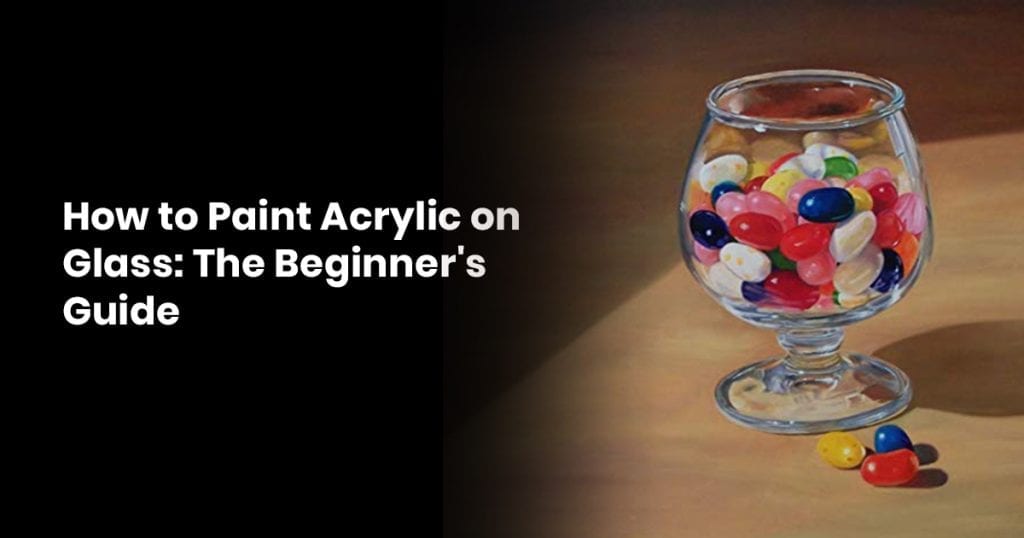Like any craft, it’ll take time before you can master the art of acrylic painting. The learning process involves a lot of trial and error. However, with the proper advice and guidance from experts who understand the art of acrylic painting, there’s no telling what you can do in this space.
This article is going to briefly explain what acrylic paint is and how it differs from several other paints and it’ll show you how to start painting with acrylics as a beginner. If you want to know all there is about acrylic painting, don’t go anywhere.
Contents
What Is An Acrylic Paint?
Before you learn how to paint with acrylic paints, you need to know what they are first and how they differ from the many other paints out there.
Acrylic paint is basically a pigment suspended in acrylic water-soluble mediums that become waterproof when dry. The benefit of working with acrylic paints versus other kinds of paint is they’re heavily pigmented, have a low odour, are fast drying and are easy to clean up. All these factors help ensure the production of vibrant and bold colours.
Compared to oil-based paints, which often take a couple of days to completely dry, acrylics dry within a few minutes. So, unlike oil paints, you can continue painting over the dried up parts and not notice mistakes. This is why this option is such an appealing option for novices and beginners.
Other important factors you might want to know about acrylics are; that they don’t spread like gouache and watercolours, they usually dry in darker hues than the pigments they display when wet, they’re fast-drying, they’re water-resistant and water-soluble.
What Materials Will You Need?
The basic essentials for painting with acrylics include acrylic-approved paintbrushes, a palette knife (for blending), a palette, a wood panel or canvas, paper towels or a rag, and detergent for cleanup.
Like with most things, you’re going to find that the material quality varies between different products. So, as a novice or beginner, avoid “professional grade” materials and go with the “student grade” or lower-cost options. The attendants at the art store should be able to show you where to start.
Okay, both grades are good, but student grade material will be cheaper and are ideal for exploring and practising new color mixing techniques and subjects. When you start feeling more confident about your painting skills, you can advance to higher-quality items.
Acrylic Paints
Some of the most reliable and leading acrylic paint brands in the business are Golden Artists’ Acrylic Colours, Liquitex Professional Acrylic Color, Winsor & Newton Professional Acrylics and Spectrum Spectracryl Artists Acrylic.
You will probably want to get a 36 or 24-piece paint set, which can easily be found in your local art store or online. You might also want to consider buying the large paint tubes for the colours you think you’ll use a lot, or really like. It is also a good idea to get the large tubes for the colours black and white because you’re going to be using them plenty for base work and blending.
ACRYLIC-APPROVED PAINTBRUSHES
For your paintbrushes, try not to overwhelm yourself as a beginner. Most artists and students alike concentrate too much on having huge selections of paintbrushes.
Purchase a few good paintbrushes and you’ll enjoy the experience way more than if you were to get a big overwhelming paint set or that inexpensive one you’ll find in plastic bags at your local art store.
Some of the paintbrushes you need to consider picking include:
- A flat brush
- A round brush
- A wash brush
- A liner brush
- An angled brush
- A fan brush
Take some time at the store and run the brush through your fingers to see how it feels. This will be like your magic wand for the next few projects. Use your fingers to run through the bristles and see how they feel. Make sure it’s what you want.
- Canvas and Easel
At the start of your acrylic painting learning process, you’ll want to consider buying a few acrylic-approved canvas boards. You can get pre-primed products or prime them yourself at home. Primed canvas boards are typically white and will often have labels such as “triple primed gesso.”
Buying cheaper paint sets allows beginners to experiment with concepts and ideas without having to worry about not fact that your canvas is worth $50 or more.
An easel may, on the other hand, may not be that necessary but you might find that it helps make the whole acrylic painting experience way more pleasurable. H-frame tabletop easels typically cost around $25 to $45 and you can store them at the house without having to sacrifice too much space.
If you want something a little stronger, consider getting gently used easels on Craigslist, eBay or Facebook Marketplace. You can even visit your local art store and find out if they have options like this in stock.
Large-standing, high-quality easels can easily cost a few hundred dollars, so try and explore all your options as much as you can.
How To Acrylic Paint As A Beginner
With acrylic paint, you have a lot of room for adaptation. This is because acrylics are not as fixable and flexible as their oil and watercolour counterparts. Follow the below step by step guide to learn how to paint with acrylics.
SETTING UP THE PAINTING STATION
You can set up the easel and painting supplies either outdoors or in a tranquil room in your home, it all depends on which you prefer. Once you pick an area, place the canvas on your easel, place a paper towel or rag near your palette and put the paintbrushes in a sturdy cup/container next to the palette.
You should place all these items according to whether you’ll be using your left hand or your right hand. If you’re going to be painting indoors, cover the flow with garbage bags, a tarp or an old rug.
EXPERIMENT AND PRACTICE WITH THE MATERIALS
One of the first steps to mastering a craft is to familiarize yourself with all its mediums. For instance, with acrylic painting specifically, it means you getting acquainted with how the paint applies, how it sets on the canvas you chose, how fast it dries up and how it mixes with other colours.
When it comes to modifying the sheen and consistency of the paint or ‘extending’ it, you can experiment with several other products. Some of these products can help make your acrylics thicker for more dimensional effects and they can also change the finish from matte to glossy.
You can also use water to dilute most acrylics to varying degrees or you can opt to use them directly from the paint tube as-is.
There are a few ways you can experiment and practice with acrylics. Each exercise below is relatively short and can help boost your confidence a great deal.
- Exercise 1- Swatch all the paints on your canvas board to see their opacity levels, how fast they dry up and how they generally apply.
- Exercise 2- As you swatch the paints, consider incorporating a few of the modifying products highlighted in this article to see how each swatch is affected. You can also find out how water impacts the opacity and consistency of the paint.
- Exercise 3- Come up with a linear gradient from white to black, and another with a pair of corresponding colours, like yellow to green, or blue to red. This will help see how the paints mix with one another.
- Conceptualizing the Painting
Before putting a paintbrush on a canvas, you’ll want to have a clear concept of what you want to paint. This can involve taking a few moments to make a rough sketch of what you want to paint using charcoal or a pencil or even just thinking about the painting you have in mind and envisioning how you want it to look.
If you’d rather come up with a rough sketch beforehand, these days you can play with various colour tones and mock-up ideas digitally before you have to start the actual acrylic painting process. Not everyone can do this. However, if you think you’re one of the folks who can go for it.
- Starting the Painting Process
Now it’s finally time to start the actual painting process. You’re now ready to create your first acrylic masterpiece. If you are a bit hesitant or scared about getting started, you might want to consider just sticking with a few colours for the moment. If you feel a bit more confident, then go all out because the world is your oyster.
How To Remove Acrylic Paints
Spilling acrylic paints on your clothes, couch or carpet can feel horrible. The most important thing you need to do when this happens is to act fast.
On hard and soft surfaces, you can get rid of the stain by first wiping down the affected area with a paper towel or rag and then scrape the residue off using a blunt knife. Once you’re done with the scraping, rinse the affected area with warm water until the stain is completely gone.
You need to work fast because this type of paint dries up very fast and it’s better to deal with it when it’s still wet.
CLEANING FROM CLOTHING
The moment you spill the acrylic, start working on getting rid of the excess paint. Then after you’ve successfully removed all the excess;
- Throw the garment straight in the washer. Add your detergent and then set the machine on cool, as hotter or warmer settings might heat-set the paint stain.
- If you can’t get that particular piece of clothing into the washer immediately, soak the garment in water until you can. It’s vital you keep the stain wet until you can throw it into the wash.
If the paint stain has already dried up, don’t fret. You can still get rid of it using acetone or hairspray. Make the affected area wet using acetone or hairspray. Once the paint stain is loos enough, scrape it off.
CLEANING FROM CARPETS AND UPHOLSTERY
Throwing your carpet or sofa into the washer is out of the question this time. So how can you clean paint that’s fallen on the floor or furniture?
- Use a butter knife, or an item with a hard edge, to scrape off all the excess paint, carefully cleaning your scraping tool after each swipe.
- Next, fill a container with tepid water. Make sure it’s big enough to fit a washcloth. Avoid using scalding hot water because this can permanently set the paint stain.
- Add some dishwashing liquid or laundry detergent and make the water soapy.
- Use the soapy water to dampen the washcloth and then blot the affected area. Don’t rub the stain because this could cause it to set and stain your carpet further. Rinse out your carpet between blots making sure you get soapy, clean water after every pass.
CLEANING YOUR PAINTBRUSHES
The best thing to do here is to constantly clean your brushes while you paint, which entails keeping a container of clean water next to you and rinsing the paintbrush once you’re done with the color or once you’re done with it.
With that said, you can also clean just clean them afterwards using either acetone or rubbing alcohol. This is an ideal method for cleaning dried up paint.
However, make sure you do this outside or in a well-ventilated room because the chemicals in these components can harm you.
Final Takeaway
Acrylics dry fast and are water-resistant, meaning they preserve really well on their own. As highlighted above, these are a few of the reasons why they’re so popular among beginner and novice painters.
Don’t be sad if you can’t create an acrylic masterpiece right out the gate. Honestly, not many beginners can. You’re just starting the artistic journey and there’s a lot more for you to see and experience down the road.
Hopefully, this article will help you be the best you can be in the acrylic painting space.




